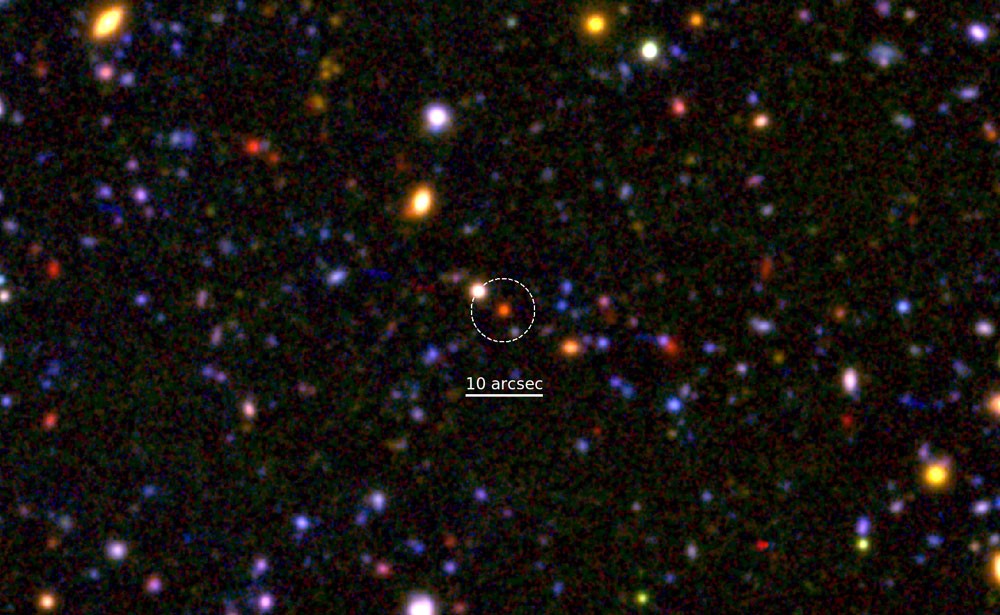DAWN: The core of the biggest galaxies was formed 1.5 billion years after the Big Bang
An international research team, including researchers from the Center of Excellence Cosmic Dawn Center (DAWN) at the Space Division at the Technical University of Denmark and the Niels Bohr Institute at the University of Copenhagen, has discovered a distant galaxy that reveals how the core of the biggest galaxies in the universe was formed 1.5 billion years after the Big Bang. That is about one billion years earlier than observations have previously shown. Astronomers’ computer models today might have to be revised, as the discovery can give us more and new information about the history of the universe. The result was published in two papers in the scientific journals Astrophysical Journal and Astrophysical Journal Letters.

An international research team, with the participation of several scientists from the DNRF Cosmic Dawn Center (DAWN) at the Space Division at the Technical University of Denmark and the Niels Bohr Institute at the University of Copenhagen, recently discovered a massive dying galaxy formed 1.5 billion years after the Big Bang. It is the most distant galaxy of its kind that has been observed, and the discovery can bring us closer to a more precise description of the history of the universe.
“This result pairs up with the fact that when these dying gigantic systems were still alive and forming stars, they might have not been that extreme compared with the average population of galaxies,” said Francesco Valentino, assistant professor at DAWN and lead author on one article as well as co-author on the other.
When a galaxy is dying, it means that it is in a process where its star formation is significantly suppressed. Therefore, quenching galaxies are not as bright as fully alive galaxies, where star formation is fully active, but they are not as dark as dead galaxies, where star formation has completely stopped. Dying galaxies are thus placed in between alive and dead galaxies, which makes them interesting for researchers to observe as they might hold some of the answers to one of the biggest questions in astronomy.
“The suppressed star formation tells us that a galaxy is dying, sadly, but that is exactly the kind of galaxy we want to study in detail to understand why it dies,” continued Valentino. “One of the biggest questions that astrophysics still has not answered is how a galaxy goes from being star-forming to being dead. For instance, the Milky Way is still alive and slowly forming new stars, but not too far away (in astronomical terms), the central galaxy of the Virgo cluster – M87 – is dead and completely different. It might have to do with the presence of a gigantic and active black hole at the center of galaxies like M87,” said Valentino.
One of the ways in which Valentino, colleagues from DAWN, and the rest of the international research team will try to learn more about dying galaxies is with NASA’s new James Webb Space Telescope (JWST). The telescope, which is the world’s largest space telescope, is planned to be sent into space in March 2021 and will provide data with much more detail than Earth-based telescopes. Earth-based telescopes generally observe extreme galaxies more easily, whereas space telescopes, such as JWST, can observe the population of normal objects of the universe, which, according to the researchers, can describe the history of the universe with more precision than today.
“Until very recently, we did not have many observations to compare with the models. However, the situation is in rapid evolution, and with JWST we will have valuable larger samples of ‘normal’ galaxies in a few years. The more galaxies we can study, the better we can understand the properties or situations leading to a certain state – if the galaxy is alive, quenching or dead,” said Valentino. He added:
“It is a question of writing the history of the universe correctly, and in greater and greater detail. At the same time, we are tuning the computer models to take our observations into account, which will be a huge improvement, not just for our branch of work, but for astronomy in general.”
Read the scientific article behind the study from DAWN in Astrophysical Journal Letters here
